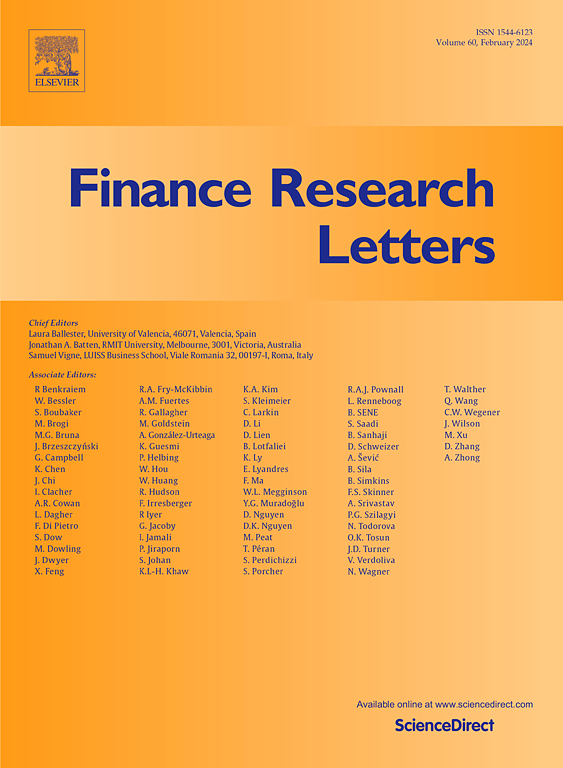The extreme risk spillover effect of international commodity price fluctuations on China's real economy: Discussing the effect of geopolitical conflicts
IF 6.9
2区 经济学
Q1 BUSINESS, FINANCE
引用次数: 0
Abstract
This paper investigates the extreme risk spillover effects from the international commodity market to China's real economy, with a particular focus on the impact of geopolitical conflicts. To this end, we utilize the Reuters CRB international commodity price index and China’s real economy industry price index from January 2019 to December 2024. A GARCH-Copula-CoVaR model is employed to quantify these extreme risk spillover effects. Furthermore, a sub-sample analysis is conducted to examine the evolution of spillover characteristics in the periods preceding and following major geopolitical conflicts. The findings suggest significant disparities and temporal variations in the extreme risk spillover effects of the international commodity market on various industries of China's real economy. On average, the energy and materials industries suffer the largest proportion of risk spillovers, as much as 59.9% and 56.4%, respectively. The Russia-Ukraine conflict triggers a substantial surge in extreme risk spillover effects across all industries of China's real economy, with the most affected industry experiencing an increase of 58.27%. However, the Israel-Palestine conflict does not result in an increased risk spillover effect for all industries. In quantifying extreme risk spillover, this study accounts for multiple characteristics of the return series and conducts a cross-sectoral analysis, thereby providing a critical foundation for precise macroeconomic policy formulation.
国际大宗商品价格波动对中国实体经济的极端风险溢出效应:地缘政治冲突的影响探讨
本文研究了国际大宗商品市场对中国实体经济的极端风险溢出效应,特别关注地缘政治冲突对中国实体经济的影响。为此,我们利用2019年1月至2024年12月的路透CRB国际大宗商品价格指数和中国实体经济行业价格指数。采用GARCH-Copula-CoVaR模型对这些极端风险溢出效应进行量化。此外,本文还进行了子样本分析,以考察重大地缘政治冲突前后时期外溢特征的演变。研究结果表明,国际大宗商品市场对中国实体经济各行业的极端风险溢出效应存在显著的差异和时间变化。平均来看,能源和材料行业的风险溢出比例最大,分别高达59.9%和56.4%。俄乌冲突引发中国实体经济各行业极端风险溢出效应大幅上升,受影响最大的行业增长58.27%。然而,巴以冲突并没有导致所有行业的风险溢出效应增加。在对极端风险溢出进行量化时,考虑了收益序列的多重特征,并进行了跨部门分析,为精准制定宏观经济政策提供了重要基础。
本文章由计算机程序翻译,如有差异,请以英文原文为准。
求助全文
约1分钟内获得全文
求助全文
来源期刊

Finance Research Letters
BUSINESS, FINANCE-
CiteScore
11.10
自引率
14.40%
发文量
863
期刊介绍:
Finance Research Letters welcomes submissions across all areas of finance, aiming for rapid publication of significant new findings. The journal particularly encourages papers that provide insight into the replicability of established results, examine the cross-national applicability of previous findings, challenge existing methodologies, or demonstrate methodological contingencies.
Papers are invited in the following areas:
Actuarial studies
Alternative investments
Asset Pricing
Bankruptcy and liquidation
Banks and other Depository Institutions
Behavioral and experimental finance
Bibliometric and Scientometric studies of finance
Capital budgeting and corporate investment
Capital markets and accounting
Capital structure and payout policy
Commodities
Contagion, crises and interdependence
Corporate governance
Credit and fixed income markets and instruments
Derivatives
Emerging markets
Energy Finance and Energy Markets
Financial Econometrics
Financial History
Financial intermediation and money markets
Financial markets and marketplaces
Financial Mathematics and Econophysics
Financial Regulation and Law
Forecasting
Frontier market studies
International Finance
Market efficiency, event studies
Mergers, acquisitions and the market for corporate control
Micro Finance Institutions
Microstructure
Non-bank Financial Institutions
Personal Finance
Portfolio choice and investing
Real estate finance and investing
Risk
SME, Family and Entrepreneurial Finance
 求助内容:
求助内容: 应助结果提醒方式:
应助结果提醒方式:


